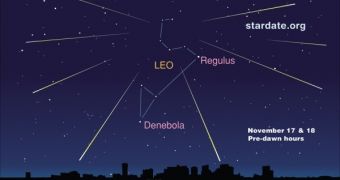This year’s Leonid meteor shower is peaking this week and the best time to enjoy the incredible show is right now.
The Leonid meteor shower is a yearly event, that occurs every mid-November, SPACE.com reports.
The comet Tempel-Tuttle passes every year near Earth's orbit, during its usual trip through the solar system and the material it leaves behind, causes the meteor shower.
As the Earth passes through these clusters of comet material, the dust and gas flare up in the atmosphere, giving birth to spectacular meteors.
Once every 33 years, the Earth comes upon a dense knot of material – the last time was in 2002, and creates an amazing display of shooting stars.
At that time, you can even see hundreds or thousands of meteors every hour.
Joe Rao, SPACE.com skywatching columnist, said that this is not the case this year, as the Earth passes through a less dense area of Comet Tempel-Tuttle's trail, but the Leonids will not disappoint you if you watch their show.
Sky-watching experts say that this year, the Leonids should be at their best on November 18, when shooting-stars passionate should be able to see between 15 and 20 meteors an hour.
You should know that the best time to try to see the Leonids are during the last two or three hours before sunrise, after the moon has set.
Rao says that “from the time of moonset until around 5:15 am – when the first streaks of dawn begin to appear in the east, the sky will be dark and moonless.
“That interval will provide you with your best opportunity to see any Leonid meteors.”
This year, there are fewer meteors expected so the best way of having a chance to spot a few, would be to leave residential areas.
“For your best view, get away from city lights.
“Look for state or city parks or other safe, dark sites,” recommend the editors of StarDate magazine at the McDonald Observatory in Texas.
“Lie on a blanket or reclining chair to get a full-sky view; if you can see all of the stars in the Little Dipper, you have good dark-adapted vision.”

 14 DAY TRIAL //
14 DAY TRIAL //